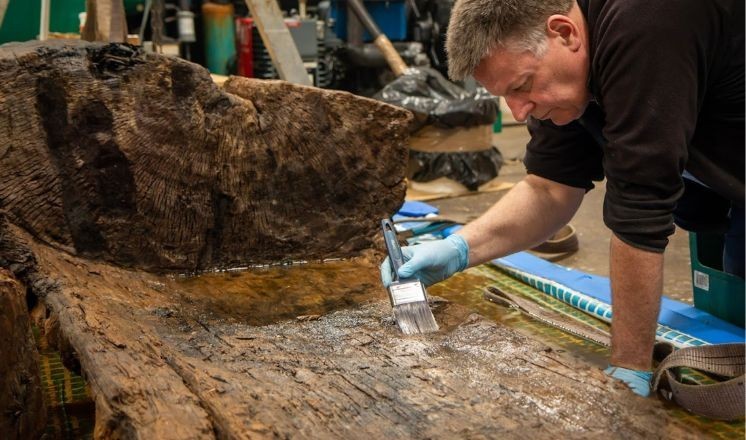4,000 years of history at your fingertips: Behind the scenes of Lincoln Museum’s exciting redevelopment
RSS FeedThe museum’s transformation is progressing at pace, and a Bronze Age coffin is one of the internationally significant objects to be showcased for the first time.
When we open our doors again next year, visitors will discover a brand-new archaeology gallery featuring interactive displays and hands-on experiences, designed to bring people closer than ever before to the county’s fascinating history.
Ahead of the eagerly anticipated re-opening, our team have shared new details about one of the incredible objects being displayed for the very first time – a 4,000 year old, three-metre-long log coffin and miniature battle-axe.
The coffin’s discovery made headlines around the world when it was unearthed by chance during works to a pond at Tetney Golf Course, in East Lindsey, in 2018.
Experts were astonished to find the remains of a man buried with a finely crafted axe - still with its wooden handle in place – a sign of high status during the period.
Since its discovery, the ‘Tetney Coffin’ has been the focus of extensive conservation, generously funded through a £110,000 grant from Historic England and completed by York Archaeology.
Further analysis and research was led by a team of independent specialists, with the coffin providing a precious glimpse into elaborate Bronze Age burial practices.
An investigation of the plant and pollen remains found inside the coffin revealed that the man was laid on a bed of oak and yew branches and had a garland of flowers around his neck. Hazelnuts and other plants may have formed part of a food offering.
Tim Allen, development advice team leader (North) at Historic England, said: "This discovery takes us to the moment in time when a man was lain to rest in a fragile landscape of woods, salt and marsh.
“Historic England acted immediately to secure this nationally important but unexpected find before it crumbled. That was the start of a painstaking process; this work would have been impossible without the cooperation of the landowner, and the expertise of Dr Hugh Willmott and colleagues at the University of Sheffield, York Archaeology and Lincoln Museum."
After the coffin had been painstakingly conserved and reconstructed, it was carefully transported to its new home in Lincoln – a delicate operation requiring detailed planning and expert handling.
Now, our conservation team are stabilising the coffin for display and overseeing the creation of a bespoke supportive mount which will enable the object to take pride of place in our new gallery.
Cllr Natalie Oliver, executive councillor for culture at Lincolnshire County Council, said: “The Tetney Coffin is one of the extraordinary objects - both in terms of its archaeological significance and its physical scale - that we’re delighted to be showcasing for the first time when Lincoln Museum reopens next year.
“I’d like to thank all the organisations who have worked so hard to protect and preserve this incredible piece of Lincolnshire’s heritage - the landowner, The University of Sheffield, Historic England, York Archaeology, and of course, our dedicated museum team.
“I cannot wait to see the coffin take pride of place in the museum’s new gallery. Thanks to the most ambitious upgrade in the building’s history, visitors of all ages will be able to explore the region’s past like never before.”
Whilst work takes place in the museum, visitors can still enjoy amazing art, activities and events over at the neighbouring Usher Gallery.
Keep up to date with the redevelopment of Lincoln Museum and what’s on at the Usher Gallery by following ‘Lincoln Museum and Usher Gallery’ on Facebook and Instagram.
Comments
There aren’t any comments for this blog yet

